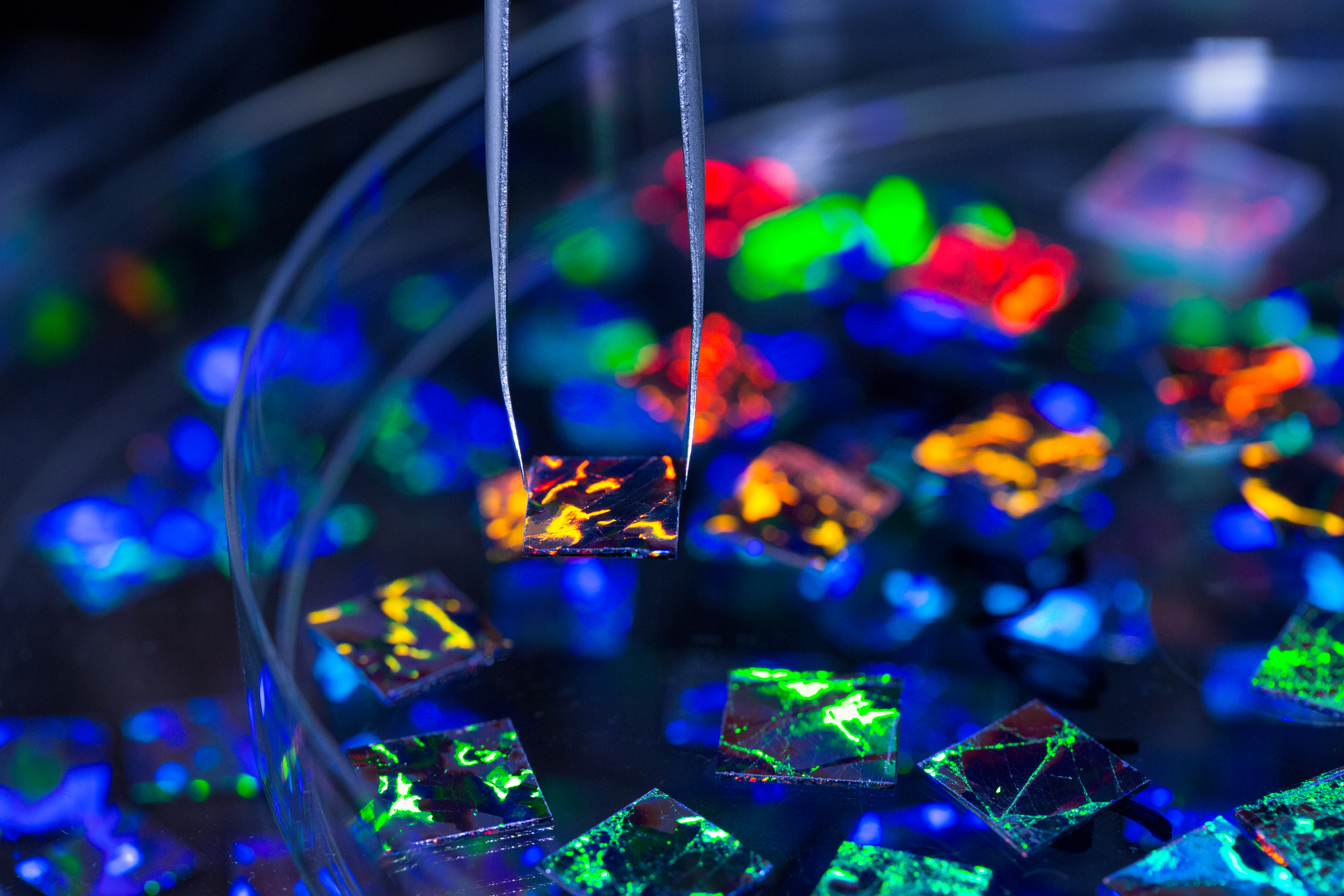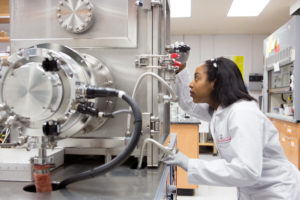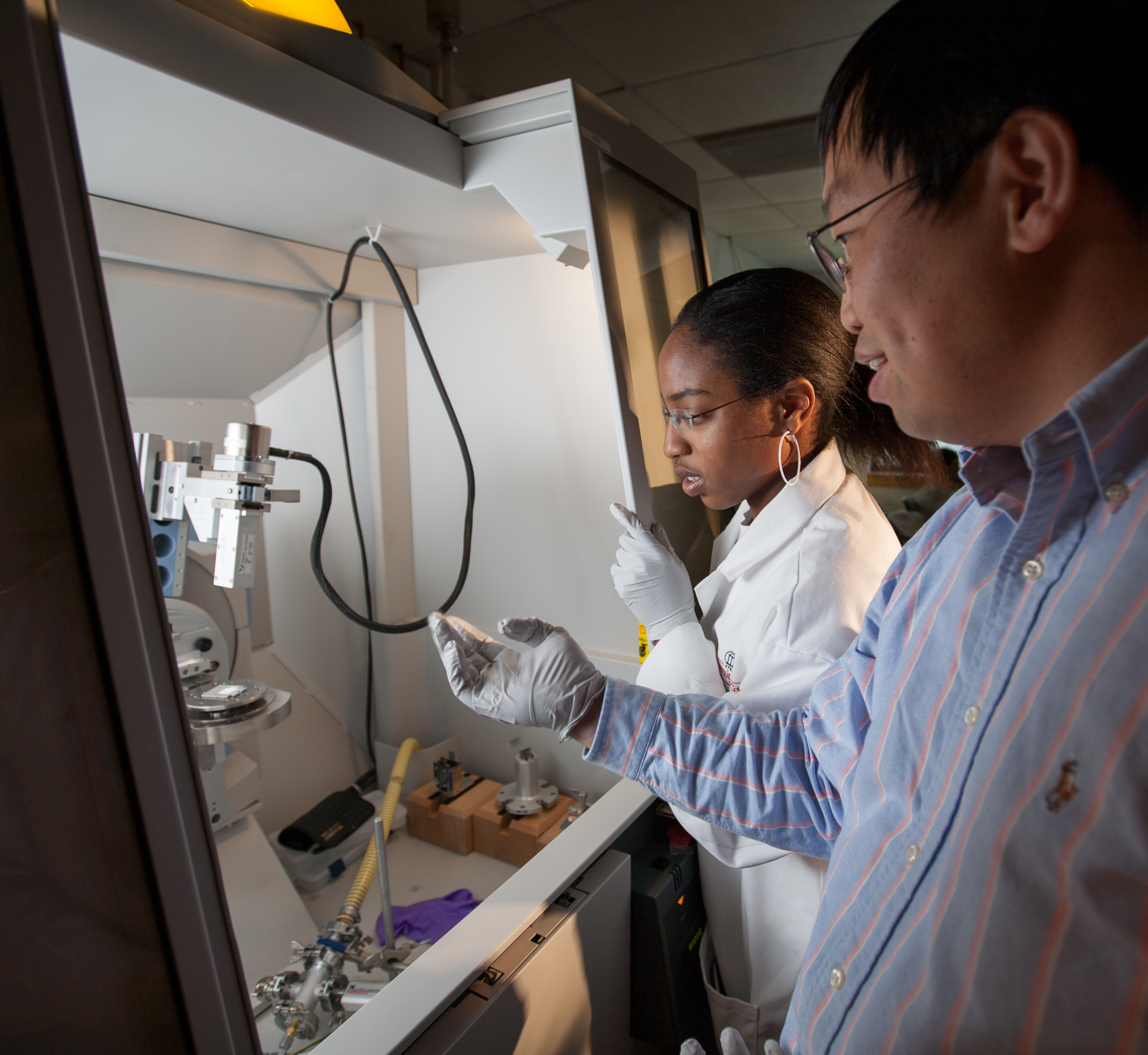No Small Matter: Whitney Ingram’s Big Dream and the Beauty of the Infinitely Small
By: Cynthia Adams | Photos By: Nancy Evelyn
When is the precise moment when someone decides to become a scientist?
Whitney Ingram, a UGA doctoral candidate in physics, remembers. She was a young girl of about eight years, living in Stone Mountain, Ga., when she picked up a National Geographic magazine. She flipped through, enjoying the photographs, and stopped at an article. Illustrating the article was a powerfully unnerving image. “I saw a piece about the sun expanding into a red giant and engulfing the Earth,” Ingram remembers.
Then Ingram read the article through. Her life wobbled on its axis. Ingram was going to put the magazine away, but what she had read remained with her. In the narration of her life, this image, this article, this magazine, was going to change the arc of her future.
It was a potent photograph and for a young girl it had made an indelible imprint. “Reading that this was the fate of our planet, it really disturbed me and I couldn’t sleep. Though this would not happen for at least another billion years, the threat felt real. I had a lot of fear; what if it happened tomorrow, I thought to myself?”
The image of a dying sun stayed with Ingram.
“It was a vivid memory because of the fear attached to it.” What she wanted to know, was, exactly when was the sun going to explode? She laughs ironically as she tells it.
A fascination with science enabled her to get answers to that and other vexing questions about the physical world. Her interest in science grew during her early experiences in DeKalb County. “I was heavily influenced in elementary and middle school. I attended Shadow Rock Elementary and Stephenson Middle School. They did offer after school science programs.” Eventually she decided to become a scientist, or possibly an engineer. As often happens, her science interests were further fueled by studies at Stephenson High School in DeKalb County, Ingram says.
“I was interested in engineering and did a lot of science fair projects. It wasn’t until meeting my high school physics teacher, Mr. Billinghurst, that I developed an interest in physics. He was really passionate about the subject. When I took the class there was only three of us in advanced placement physics. I really enjoyed the way he taught the class, and he spoke in a way that was easy to understand and the hands-on experiments were really fun. He agreed to be my mentor and support me in a Science Olympiad.” Ingram learned later that her physics teacher had actually deferred retirement for a year until she graduated.
Whitney Ingram will graduate this December with a doctorate in physics. Ingram will be the first African-American woman to graduate with a degree in physics from the University of Georgia, and will join a small and distinguished coterie of minority women in her profession. As of last year, there were approximately 89 PhDs in physics held by African-American women in the US, including living and deceased. By her estimate, there will be perhaps as many as 100 total by the date she graduates.
After high school, Ingram was interested in biomedical engineering but decided to enter physics. The year was 2007 and she was then “deliberating between UGA and Berry College.” She chose UGA, receiving a HOPE Scholarship, and other financial awards. These included scholarships from Georgia Power Company’s Association of Blacks in Energy, Delta Sigma Theta Scholarship (Stone Mountain-Lithonia alumni chapter) and the Tuskegee Airmen scholarship.
During Ingram’s freshman year at UGA, she was a part of the minority undergraduate research program, the Peach State Louis Stokes Alliance for Minority Participation (PS-LSAMP). Her mentors at PS-LSAMP encouraged her to apply for the Graduate School’s Summer Undergraduate Research Program (SURP) for additional financial support. It was during that time that Ingram met Angela Jewell, an administrative manager in the Graduate School.
Jewell recalls their initial meeting in 2008. “In a given year, at different recruitment events, I probably meet 75-100 students that I actually engage with—we meet hundreds. Ingram was one I engaged with.” Jewell continued checking with Ingram periodically in order to discuss her progress towards entering the doctoral program. “When she went into her department, she was a little shy,” Jewell noticed.
“Over the last couple years, she has grown into this very strong and bold person,” she observes. “Another thing that stood out was how determined she was.” As part of the SURP program, Ingram was required to meet certain criterion, including creating a poster presentation, preparing a written presentation, and also giving an oral presentation. “Whitney did a wonderful job on all three,” Jewell says. “Whitney also stayed very connected with the Graduate School,” Jewell adds. “She will volunteer to serve on panels when we host events. She likes to help other students. It’s amazing to see how she has grown.” She remained engaged with Ingram thereon.
“She is a friend and mentor and we have kept in touch,” Ingram says about Jewell.
Early on, Ingram also got to know a key mentor within the physics department. “I did undergrad research since the summer of 2008 for the professor who is now my current PhD professor, Dr. Yiping Zhao.”

A succession of other awards and honors followed for Ingram while still an undergraduate. She earned a CURO summer fellowship, and the UGA physics department’s prestigious Linville L. Hendren Memorial Scholarship for outstanding proficiency in physics. Ingram was well on the way to becoming a double dawg with a UGA doctorate.
She completed a bachelor’s degree in physics in 2011 and continued working towards her doctorate. As a graduate student she won a Southern Regional Education Board (SREB) fellowship and the prestigious Alfred P. Sloan scholarship in 2012 and 2013 respectively. In 2015, Whitney was awarded the Department of Energy’s Science Graduate Student Research (DOE-SCGSR) fellowship. Then, as an ultimate prize, she was chosen last summer as one of 65 students to represent the US delegation to attend the Annual Nobel Laureate Conference in Lindau, Germany. Her lead professor, Zhao, had nominated her for the honor.
The Beauty of Scale: Nanoparticles and Nanotechnologies
Ingram had long since abandoned a fascination with the dying sun. Now she looks downwards toward the nanoscale versus looking upwards.
Or, as Ingram explains to fellow scientists or physicists: “I tell them, ‘You prefer to look up and I prefer to look down.’”
Rather than contemplating the imponderables of an infinite firmament, Ingram considers the science of the infinitely small: nanoparticles and nanostructures.
 After Ingram earns her doctorate late this year, she has scarcely had time to determine where she will land next.
After Ingram earns her doctorate late this year, she has scarcely had time to determine where she will land next.
She is doing developmental research in nanomaterials used for sensing applications. It is not easily visualized, but Ingram gives it a patient attempt.
“My research interest is in the field of nanotechnology,” says Ingram. “I design and study the properties of nanostructures with structures on a scale of about a one hundred to a thousand times smaller than the thickness of your eyelash. We use these to study how we can manipulate these into something useful. We make them, study them, and analyze them primarily for sensing applications.” She explains there are other nanotechnology projects in Zhao’s research group in play, such as the study and application of nano-motors, which are useful in working with blood clots, or for detection of decomposing contaminates in water, known as photocatalysis.
She has been conducting research at a government facility with a graduate student research team as part of her DOE fellowship. “I’m studying how to design and use nanostructures as sensors to quantitatively detect low concentrations of substances, such as water isotopes or water contaminants like dyes. My research is not only to develop and optimize the nanostructures for the best possible results, but their practical application towards real world problems.”
Time Out with Whitney Ingram
What do you do for fun?
“If I do have any recreational time? Because, I’m in the lab in the mornings and also go back at night. I enjoy working out a lot. I go to the gym and take kick boxing. On rare occasions I like to travel. “Movies are a rare treat. I saw the Deadpool movie—it’s been a while—I’m not a big fan of the dystopian movies. I am a bit of a comic book fan.”
As for self-discipline?
I have to block that stuff (Facebook and YouTube) and so I have a daytime blocker so I won’t do it—the blocker will come up and say I shouldn’t be doing it.”
Favorite song?
I’m a huge fan of Michael Jackson. I love the “Earth Song.”
Other Outlets?
“When I have time I volunteer at The Daily Bread. (This is an Athens initiative to feed the homeless). Every Friday morning we cook breakfast; everybody is so thankful there. In South Carolina, my schedule is different. I just enjoy driving around the countryside. I like space and the country; there are lots of horses around Aiken. I am also a huge fan of National Public Radio, NPR. I enjoy listening to podcasts such as ‘Science Friday’, ‘Radio Lab’, ‘Wait, Wait Don’t Tell Me’, ‘This American Life’ and so much more. I really enjoy listening to them during the long drives, like to the Savannah River national Lab.”
From June 2015 until May of this year, Ingram spent much of her time between UGA’s labs and the Savannah River National Laboratory (or SRNL) in Aiken, SC in the DOE’s Office of Science. Ingram has become familiar with the SRNL’s facilities and worked to develop her research and protocols while presenting to colleagues onsite. “They work towards managing a safe and secure environment for the storage of nuclear weapons and nuclear material, and alternative energy techniques such as hydrogen energy production,” she explained via a phone interview while working onsite at SRNL this year.
Ingram’s research goal at the SRNL is aimed at detecting nuclear material at much lower concentrations than with conventional methods using inexpensive techniques. “This is where nanostructures come into play. They can be cost effective and very simple to use as sensors,” she clarifies.
Ingram worked with SRNL principal investigator Simona Hunyadi Murph. Murph is among SRNL’s youngest principal investigators.
She says Ingram had “the unique opportunity to become an expert in her field by applying state-of-the-art scientific techniques and practical, high-value, cost-effective solutionsto complex technical problems,” and mentored Ingram’s development of novel nano-materials at UGA.
Murph writes in an email, “The cutting-edge nanomaterials produced at UGA by Whitney are being characterized and evaluated for their ability to promote surface-enhanced Raman scattering (SERS) of nuclear waste analytes present in aqueous environments.”
Back at UGA, Ingram worked with bulk materials in the creation of nanostructures used at SRNL.
“The technique is called physical vapor deposition,” she explains. Nanopatterns are prepared by placing substrates—glass or silicon chips— inside a large metal chamber containing a small bowl, or crucible. A large variety of materials can be placed into the chamber including gold, silver, and copper.
Ingram works primarily with silver. She places the silver inside the crucible and melts it with an electron beam under very low pressure until it begins to melt and vaporize. As this occurs, Ingram manipulates substrate positions using motors within the chamber.
“When the material melts and begins to vaporize, we can design two and three-dimensional nanopatterns as the metal cools onto the substrate.”
Murph adds that this research work aligns with the University of Georgia, SRNL, and DOE’s mutual goals to support national defense, homeland security, and nuclear programs. Also, she says that Ingram’s research helps develop technologies in conjunction with nuclear materials.
It had been a rapid rise for Ingram, now age 26, from being a kid growing up in the Atlanta suburbs to a doctoral student well on her way to a stellar career. But there was more that made her ascendance particularly special: Ingram was among an elite corps.
Very few women of color held doctorates in physics. And few college students in the entire world have the chance to attend a Nobel Laureate Meeting.

In the Company of Giants at Lindau
Last year, Zhao’s nomination of Ingram to attend the Nobel Laureate meeting was successful and Ingram was selected as one of 65 students in America. It was even more meaningful as she met fellow attendees. She made friends from all over the world, and hobnobbed with Nobel Prize winners.
“The conference is intense. You choose lectures delivered by the Laureates, and then have lunch; then, attend more discussions and dinner. Besides meeting the Laureates, the best thing was meeting and having discussions with the other scholars from different parts of the world,” she says.
Lindau crystallized other things, intangibles. Ingram had found many supportive people among her UGA family, but she met others at the event that had not. “When these people talk, they often had little support from their peers,” Ingram noted.
Ingram met Angela Jewell, an administrative manager in the UGA Graduate School, in 2008. “Over the last couple years, she has grown into this very strong and bold person. Another thing that stood out was how determined she was,” Jewell says. As part of the SURP program, Ingram was required to meet certain criterion, including creating a poster presentation, preparing a written presentation, and also giving an oral presentation. “Whitney did a wonderful job on all three,” Jewell says. “She is a friend and mentor and we have kept in touch,” Ingram says about Jewell.
She is still processing how the Nobel Laureates and their messages affected her. “It made me realize I had to think bigger. They (the Nobel Laureates) wanted to be the ones to create something new. What challenges are people not taking on today, and yet, perhaps they are possible?”
Ingram says, “I came back with a broader sense that I can do something substantial. Maybe it won’t be easy—but just stay focused. It is what separated the Nobel Laureates from others. Their stories were very interesting: one Laureate had dropped out of high school, and another actually built a specialized microscope in his home and published his results without the support of the University.” Eric Betzig went on to win a Nobel Prize in Chemistry in 2014.
She has research ideas she may explore after graduation. But for now, Ingram is working on designing and studying nanostructures, developing unique patterning techniques shaped by close nanospheres and nanopatterns. “We can create a vast variety of patterns from these simple structures and also study their optical properties, noting how they interact with light. We can apply this knowledge towards developing sensors for low-concentration detection of select chemicals.”
Ingram explains that it is possible to change the nanostructure pretty easily. Each can have its own unique optical features. A scanning electron microscope, or SEM, and an atomic force microscope, or AFM, are needed to actually work with these minute
structures.
“Here in Dr. Zhao’s lab is one of the few labs in the world that can do the fabrication, experimental and computational characterization, and application, of nanostructures—with just the facilities we have at UGA.” Ingram creates the nanopatterns in the lab back at UGA, where they have the specialized equipment needed. Ingram returns to SRNL with nanostructures she prepared in Athens.
Ingram says, “Nanopatterns are easily created. You can design anything you want given you have the right design features.” Right now, she says she is working towards that end, “more interested in pushing the envelope to create our design.” Ingram is refining her technique in working with a particular type of radioactive material.
“The field that I work in is called SERS. It is a technique that is highly sensitive. It can be used to detect small organisms, such as bacteria, viruses, organic contaminants, heavy metals, and more. I am more interested in tritium oxide; it is produced with plutonium devices. Because we deal with nuclear maintenance it is an abundant material. If that gets into the water supply it is potentially dangerous, so detection techniques are important. Eventually, I do want to move onto the detection of other nuclear material such as uranium and plutonium.”
Her research, Ingram stresses, falls “more on the fundamental side of how to make it better. The application of this is what I do at the Savannah River site.”
As an aside, Ingram mentions also working in the field of metamaterials. These nanostructures interact with light in such a unique way they are studied and used for stealth technology.
“The theory was known since the 1960s,” she explains. “But now we have technologies to do it.” This veers into Harry Potter territory, and we discuss the famous cloak of invincibility the fiction popularized. But in fact, Ingram laughs, the possibility of objects being made invisible isn’t exactly the stuff of fiction.
“It is here and there are people doing research on it. It’s a popular and active field of research.” Nanomaterials, nanostructures and metamaterials—they all may be so small as to be invisible to the naked eye. But these minute structures are of demonstrable use.
Post-Lindau, Ingram’s ambitions as a physicist have only grown bigger.

Whitney Ingram & Angela Jewell








